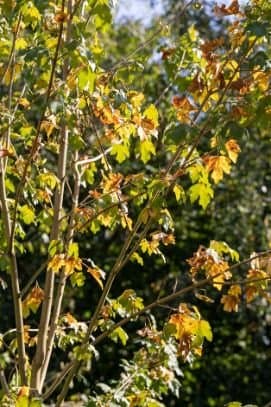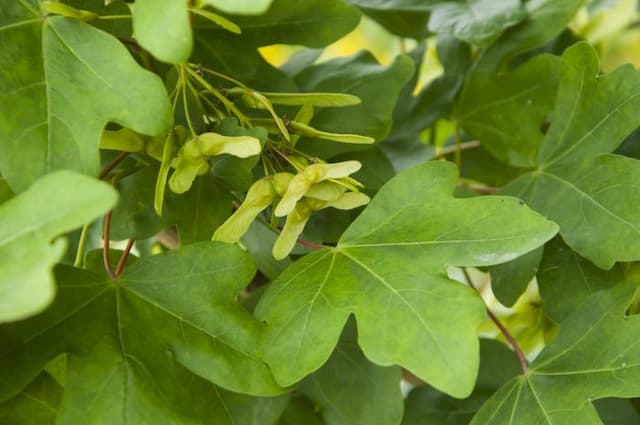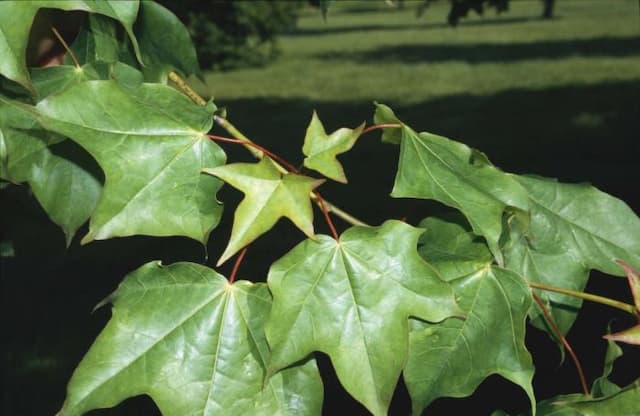Golden Box Elder Acer negundo 'Kelly's Gold'

ABOUT
Kelly's Gold is a distinct variety of the boxelder maple known for its striking foliage. It possesses a captivating appearance due to its unique leaf color. The leaves are compound, meaning each leaf is composed of several smaller leaflets. These leaflets are characterized by their radiant golden-yellow tone, which adds a splash of brightness to the landscape. The golden leaves are especially notable in the spring, which is when they display their most vibrant hue. As the seasons progress, the color may transition to a more greenish-yellow. Emerging from the branches, the leaves are arranged opposite to each other, and the individual leaflets typically range from three to seven per group. The plant also produces clusters of small, inconspicuous flowers that may not be as eye-catching as the foliage. The tree's bark is rough and furrowed, providing textural interest to the overall look of the plant. With the changing seasons, Kelly's Gold can undergo transformations in color, yet it maintains an ornamental appeal throughout. In autumn, the leaves may shift to a less intense yellow, sometimes with hints of green, before they fall off as part of the plant's natural cycle. The combination of the golden leaves against the gray-brown bark creates a contrasting visual effect that can be quite attractive in gardens and landscapes.
About this plant
 Names
NamesFamily
Sapindaceae
Synonyms
Kelly's Gold Boxelder, Golden Boxelder Maple, Kelly's Gold Ashleaf Maple
Common names
Acer negundo var. violaceum, Negundo aceroides, Negundo aceroides var. violaceum, Negundo negundo.
 Toxicity
ToxicityTo humans
Boxelder 'Kelly's Gold' is not known for being highly toxic to humans. However, like many plants, it may cause mild stomach upset if ingested in large quantities. It is always advisable to avoid eating parts of ornamental plants due to potential individual sensitivities and the possibility of unknown toxins.
To pets
Boxelder 'Kelly's Gold' is similarly not known to be highly toxic to pets. It should be noted, however, that pets may have different sensitivities compared to humans, and the ingestion of plant material could potentially lead to gastrointestinal upset like vomiting or diarrhea. It is best to prevent pets from consuming parts of this plant.
 Characteristics
CharacteristicsLife cycle
Perennials
Foliage type
Deciduous
Color of leaves
Yellow
Height
15-20 feet (4.6-6 meters)
Spread
15-20 feet (4.6-6 meters)
Plant type
Tree
Hardiness zones
2-10
Native area
North America
Benefits
 General Benefits
General Benefits- Landscape enhancement: Acer negundo 'Kelly's Gold', commonly known as 'Kelly's Gold' Boxelder, adds vibrant color to landscapes with its golden-yellow foliage that stands out in garden settings.
- Shade provision: Like other maples, this cultivar can grow to a considerable size, providing shade in gardens and on patios during sunny months.
- Seasonal interest: 'Kelly's Gold' Boxelder has a seasonal progression, with bright foliage in the spring, greenish tones in summer, and golden hues in autumn, offering changing visual appeal throughout the year.
- Wildlife habitat: Boxelder trees provide shelter and nesting sites for various bird species, contributing to local biodiversity.
- Erosion control: The root systems of maples, including this variety, can help stabilize soil and prevent erosion on slopes or in areas prone to soil loss.
- Urban tolerance: This tree variety is tolerant of urban conditions, including pollution and compacted soils, making it suitable for city environments.
- Easy propagation: Boxelders can be easily propagated from seeds or cuttings, allowing for straightforward cultivation and reproduction.
- Hardiness: 'Kelly's Gold' Boxelder is known for its ability to withstand a range of climatic conditions, making it a resilient choice for different hardiness zones.
 Medical Properties
Medical PropertiesThis plant is not used for medical purposes.
 Air-purifying Qualities
Air-purifying QualitiesThis plant is not specifically known for air purifying qualities.
 Other Uses
Other Uses- Wildlife habitat: Boxelder 'Kelly's Gold' offers nesting sites and shelter for birds and small animals with its dense branches.
- Erosion control: The fibrous root system of Boxelder can help stabilize soil and control erosion on slopes or riverbanks.
- Woodworking: Although not the first choice for lumber, its wood can be used for making small wooden objects like crates or pallets.
- Photography backdrop: The bright golden foliage of 'Kelly's Gold' can provide a stunning backdrop for outdoor photography.
- Artistic inspiration: Artists may use the vibrant color and form of the plant as inspiration for paintings, drawings, or other artwork.
- Seasonal decoration: Branches of 'Kelly's Gold' can be used in decorative arrangements or wreaths, especially in the fall when its leaves change color.
- Urban greening: This tree can be used in urban planning for its ability to adapt to city conditions and add visual interest to the landscape.
- Privacy screen: Planted in rows, Boxelder can act as a natural privacy screen or windbreak for homes and gardens.
- Craft materials: The seed samaras and leaves of the Boxelder can be used in crafting for making collages or nature-inspired art pieces.
- Educational resource: Boxelder can be used in schools or educational programs to teach students about native plant species and their role in local ecosystems.
Interesting Facts
 Feng Shui
Feng ShuiThe Boxelder Maple is not used in Feng Shui practice.
 Zodiac Sign Compitability
Zodiac Sign CompitabilityThe Boxelder Maple is not used in astrology practice.
 Plant Symbolism
Plant Symbolism- Adaptability: The Acer negundo 'Kelly's Gold', also known as the Boxelder Maple, is known for its ability to grow in a wide range of soil types and environmental conditions, symbolizing the ability to adapt and thrive in varying circumstances.
- Strength: As a member of the Maple family, this tree represents strength and endurance, as maples are often sturdy and can withstand harsh conditions.
- Balance: The contrasting golden-yellow foliage of 'Kelly's Gold' against the more common green shades in nature suggests a balance between uniqueness and harmony within the natural world.
 Water
WaterFor Kelly's Gold Boxelder, it's important to provide consistent moisture, especially during its first few growing seasons to help establish a robust root system. Watering should be done deeply once or twice a week, depending on rainfall and soil drainage conditions. Generally, one inch of water per week, including rainfall, is recommended. During periods of drought or extreme heat, increase the frequency to prevent stress. Young trees benefit from having a layer of mulch to retain soil moisture.
 Light
LightKelly's Gold Boxelder thrives best in full sun to partial shade conditions. Ideally, it should receive at least 6 hours of direct sunlight per day for optimal foliage color. A spot with morning sun and afternoon shade can also be beneficial, especially in hotter climates to prevent leaf scorch.
 Temperature
TemperatureKelly's Gold Boxelder can tolerate a wide temperature range and is hardy in USDA zones 3 through 7, which corresponds to minimum temperatures of -40 to 0 degrees Fahrenheit. The ideal growing temperatures are between 60 and 70 degrees Fahrenheit. This variety is adaptable but may suffer foliage damage if exposed to temperatures above 90 degrees Fahrenheit over extended periods or if sudden temperature drops occur during its growing season.
 Pruning
PruningPruning Kelly's Gold Boxelder is necessary to maintain the desired shape and health of the tree. Prune during dormancy in late winter or early spring to remove dead or damaged branches, to control the shape, and to encourage more vigorous growth. It may also be pruned in summer, after the leaves are fully developed, to correct any structural issues or to manage the tree's size.
 Cleaning
CleaningAs needed
 Soil
SoilBoxelder 'Kelly's Gold' thrives best in a well-draining soil mix with plenty of organic matter. A mixture of loam, peat moss, and perlite is ideal, aiming for a slightly acidic to neutral pH of 6.0 to 7.5 for optimal growth.
 Repotting
RepottingBoxelder 'Kelly's Gold' is typically planted outdoors and does not require frequent repotting. However, if grown in a container, young trees should be repotted every 2-3 years to ensure adequate space for root development.
 Humidity & Misting
Humidity & MistingBoxelder 'Kelly's Gold' prefers average humidity levels but is adaptable to a wide range of conditions. It does not require any special humidity accommodations when planted outdoors.
 Suitable locations
Suitable locationsIndoor
Provide bright light, well-draining soil, and water when dry.
Outdoor
Plant in full sun to partial shade, mulch, and water regularly.
Hardiness zone
2-10 USDA
 Life cycle
Life cycleThe 'Kelly's Gold' boxelder (Acer negundo 'Kelly's Gold') begins its life cycle with seed germination in the spring, when the soil warms and moisture content is high. The seedlings then establish a root system and a shoot that pushes through the soil surface, displaying its characteristic yellowish-golden leaves. As it enters the sapling stage, the tree increases in height and girth, developing a branching structure over several years. At maturity, which can take multiple decades, it achieves its full size—typically around 15 to 25 feet tall—and begins to produce small clusters of flowers, followed by winged seeds, called samaras, that disperse in the fall. The mature 'Kelly's Gold' flaunts its striking golden foliage throughout the growing season, with the leaves then turning a pale yellow before falling off in the autumn. Eventually, after many years, the tree will enter a senescence phase where growth slows, and it may become more susceptible to environmental stressors and disease before eventually dying.
 Propogation
PropogationPropogation time
Early spring
Acer negundo 'Kelly's Gold', commonly known as Golden Boxelder, is best propagated by softwood cuttings taken in late spring to early summer. This is when new growth is mature enough yet still flexible. To propagate by cuttings, select a healthy, non-flowering stem and cut a 4 to 6-inch (10 to 15 cm) length, making sure it has several leaf nodes. Remove the leaves from the lower half of the cutting and dip the cut end into rooting hormone to increase the chances of successful rooting. The treated cutting should then be inserted into a well-draining potting mix, with about half of the cutting's length in the soil. Ensuring high humidity and consistent moisture is crucial, so covering the pot with a plastic bag or placing it in a propagator can be beneficial. Cuttings typically root in several weeks, after which they can be gradually acclimated to normal growing conditions before being transplanted outdoors.







![Freeman maple [Autumn Blaze]](/_next/image?url=https%3A%2F%2Fplants-admin.emdemapps.com%2Fimages%2Fplants%2F%2Fimages%2F604b575b84d87.png&w=640&q=75)

